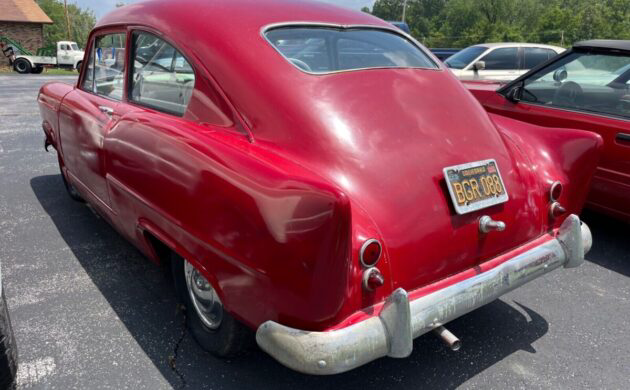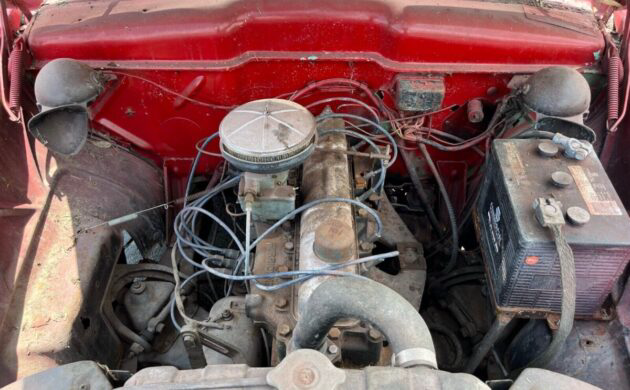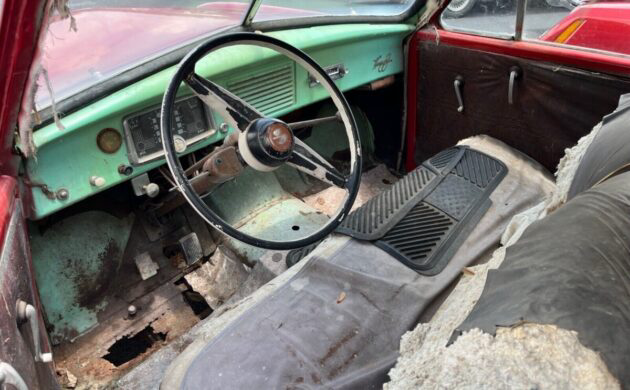Post-War Compact: 1951 Kaiser Henry J
The small and economical Kaiser Henry J may have been the right car but at the wrong time. The assumption after World War II was that buyers would scoop up thrifty cars in large numbers. Instead, with years of pent-up demand, almost anything on four wheels sold well into the early 1950s. Named after the company’s chairman, the Henry J only lasted from 1951 to 1954 and accounted for 130,000 cars, but most of that was in 1951-52. A non-running project, this Kaiser is in Dongola, Illinois, and is available without a title for parts (you could restore it, but the floors are shot). It’s available here on eBay where bidding has settled in at $2,051.
Introduced in the Fall of 1950 (after most of the U.S. automakers already had all-new post-war cars), Kaiser-Frazer Corp. rolled out the tiny Henry J. It was available with both four and six-cylinder power, supplied by Willys-Overland (aka Jeep). Using similar logic that brought about the Ford Model T (cheap, mass-produced transportation), Kaiser wanted to target buyers who only had enough money to buy a used car. But they missed the mark as buyers could get a bigger Chevy 150 sedan for less than a couple of hundred bucks more. To help boost sales, Kaiser also rebadged them as Allstates to be sold by Sears, but that didn’t help much.
The seller’s car is the Deluxe edition which came with a 161 cubic inch inline-6 that produced 80 hp, but we’re told it might not be original to the “J”. It should be paired with a 3-on-the-tree manual transmission. The engine does turn, but it quickly dies when you try to start (bad gas?). These were simple machines in their execution, so perhaps herculean efforts won’t be needed to get it running again. But we’re told it has a salvage title, so maybe it would be better used for another Henry J project.
Overall, the body looks decent, and the red paint may be a color change (the interior and parts of the doors are green). But the floors are goners and – while attempts have already been made to patch them – gaping holes are still present. The upholstery is a also lost cause, but recovering the seats would be too bad of a job. If you were to take this Kaiser home at the right price, what would you do with it?
Auctions Ending Soon
 2006 Ford Mustang Saleen S281 SCBid Now16 hours$15,000
2006 Ford Mustang Saleen S281 SCBid Now16 hours$15,000
 2002 Subaru Impreza WRXBid Now3 days$333
2002 Subaru Impreza WRXBid Now3 days$333
 1975 Chevrolet Corvette ConvertibleBid Now3 days$3,000
1975 Chevrolet Corvette ConvertibleBid Now3 days$3,000
 1964 Ford F-100 Camper CustomBid Now3 days$2,000
1964 Ford F-100 Camper CustomBid Now3 days$2,000
 2006 Jeep Wrangler SportBid Now5 days$10,500
2006 Jeep Wrangler SportBid Now5 days$10,500





Comments
Rare to see these today. I’ve seen more of these made into drag cars than I’ve seen on the road.
Yep, have you seen what Ian Roussel did in chopping the top on one. I’d like to see one of these with his chop, but with another final use point. Wonder how one would do as a dune buggy with a Suburu flat 4 and a Bug transaxle? Or maybe with Honda FWD 4? Or maybe on an AWD Audi TT?
I’m getting into Ian’s weird ideas for stuff…obviously.
Saw that. Ian did quite a number on that build.
Nobody wanted them.
Henry (J) Kaiser wasn’t an auto man; he was, all his career, a GOVERNMENT CONTRACTOR. He got his start paving roads, then excavating and grading gravel for major public-works projects. Then on to the Hoover Dam, and then, building Liberty Ships during the war, using many assembly-line techniques. Quality was suspect but the ships were quickly finished, and serviceable enough to serve through the war.
Out of the war, Kaiser’s dreams drifted to the auto industry. The vanity appealed to him – a fashion statement that the company, or owner controlled…with sales, again and again. He saw the Ford, Chevrolet and Chrysler names become commonplace, and wanted to try it. No doubt he believed he could do better than how Detroit, now a mature industry, was working.
He miscalculated his capital needs. That was inherent in his optimism and his gambler’s nature; but he ALSO had no understanding of how to control the supply chain of big-ticket consumer goods. His idea was to build them first, stockpile them, and let dealers buy as they would. “Like cans of beans at a grocer’s,” his son Edgar Kaiser, later CEO of Kaiser-Jeep, said.
That didn’t work, and Kaiser-Frazer was soon in trouble. Kaiser’s understood business model was, government connections – he first got a Small Business Administration bridge loan to sustain K-F for a year or so. THEN his ears pricked up to pressure from parts of the government, to subsidize and encourage launch of a “People’s Car.” Kaiser, without a V8, a newcomer with little status, was right there.
The mule for what became the Henry J had already been designed and prototyped by an industry sheet-metal supplier, with no resources or record in the retail auto business. Using government funds, Kaiser purchased the designs, adapted his engines to fit…and modded the designs to meet the laborious government demands.
There was one problem: Nobody wanted the thing. Nobody but government planners, who wanted it for the Little People. Who themselves wanted long Cadillacs or large new Fords.
This project turned into one more source of cash-burn for Kaiser-Frazer, which couldn’t afford it. Joe Frazer quit in disgust, after his decision to scale back production to match sales, was overridden. Eventually, reality caught up with Henry Kaiser – who was not ruined; his other businesses were doing well, but while he wanted into the auto business, he wasn’t going to stake his entire fortune and future on it.
Instead he retreated to what he knew: Government contracts. Willys, losing money trying to also break into civilian autos once again, was in trouble and willing to sell itself. Kaiser Industries bought it; had Willys buy the remains of Kaiser-Frazer, and renamed the whole business Willys Motors. Product lines were shrunk to the military-spec vehicles, and the few civilian derivatives Willys-Overland made. The Jeepster was killed, but the Basket-Weave station wagon and pickup survived, the only civilian-intended product left.
And in that niche, protected with government purchase orders, Willys Motors, later Kaiser Jeep, did fine, up to Henry’s 1967 death.
This specimen is testament to Henry’s blindness to civilian tastes and marketing…which mirrored those in government offices.
Very well put. Kaiser’s story is reminding me of some of these Greenie EV “truck” makers. Most are falling on their faces, even after being propped up by us taxpayers.
Big oil gets lots of government subsidies and tax breaks and there’s no shortage of demand for oil.
Only problem with this narrative is that Kaiser-Frazer had started with big cars, and those were flopping once the postwar sellers’ market died down. Most of the independents looked to the ’50s knowing it would soon evaporate and survival meant finding a niche, a market segment ignored by the Big 3.
Not only Kaiser but Nash, Willys and Hudson opted for compacts. Nash was the first to market with the Rambler in 1950, at which point the Korean War was underway and material rationing forced them to maximize profit-per-unit by launching higher-margin well equipped models (again, echoing the auto industry’s chip shortage, although that was not caused by government edict but self-imposed by their own haste in cancelling their orders in spring 2020 just as demand for other electronic devices skyrocketed and despite knowing full well the lead times stretched into years. But I digress.)
That meant the Nash Rambler was seen as desirable and aspirational, unlike the strippo Henry J or dowdy Ford-clone Hudson Jet which were launched into the teeth of a Ford-Chevy price war that made them more expensive for less metal and no USP. Perhaps if the Jet had been launched with the originally-planned Italian lines it too would’ve survived into the late ’50s when Ford and Chevy became unwieldy bechromed beasts.
The government was offering tax breaks and subsidies for makers of smaller cars. And steel and aluminium were being informally rationed at the industry level – because of the Korean War.
Kaiser, Willys, Nash and Hudson all launched small cars – and Chevrolet and Ford had stillborn small-car plans. Which of the ones actually built, survived? Nash came closest – the Rambler soldiered on a few years before being increased in size to the Rebel it became. The original Nash Rambler was pulled from production…remarkably the tooling was stored, and was brought out, updated, to quickly make the Rambler “American” in the late 1950s.
But it failed, or did not succeed, on initial launch.
Nor did the Jet, nor the Aero series, nor the Henry J. Nor the Cadette proposal, nor the Ford Cardinal, which only saw development as the European Taunus.
It simply was not what buyers wanted, at that time. Tastes change, and by 1960, Americans were tired of the Bulgemobile look…but that hadn’t happened yet.
Similar failures in auto marketing have happened all the time, when models or proposals or even types, are out of phase with what buyers want. What sold in the 1960s, would not sell a decade later. The large pickup-based SUV was out of fashion by the early 1990s; but until recently, buyers couldn’t get enough big 4x4s.
A Willys Hurricane 6 I believe
Every Henry J i have ever seen in person has been a drag car or street rod.This is such a rarity it deserves to be restored and left totally original.New floor pans aren’t a huge project but takes good skill level to DIY.Alot easier with framed cars versus unibody cars.helps to know how to weld too.I have done some floor pan replacement on a few cars i have owned,always takes longer than you think.
There are a few more around. There is one near me in Portland TN that is very restorable and has the original F head. They want 6K
I think it has a AMC engine. The original was a flathead.
No, the Willys inline 6 was an F-head design, with the intake valves in the head and the exhausts in the block. AMC’s OHV inline sixes had all the valves in the head.
I had both a 51 and a 53 Henry Js. They were unique oddities, and I did enjoy driving mine just for the fact they were oddities. Mine had flat head sixes. One had a regular 6 the other had a Kaiser Frasier Super Sonic with O/D. I bought these MANY years ago and fixed them to drive. They weren’t beat up just weather worn. 51 had no trunk lid but the 53 did. Bought them both for 400 and sold them for well let’s say a handsome profit. Love to have them back along with a few others.
I believe the Korean conflict broke out in June of 1950, and there were some buyers who feared a return of WW II gas rationing. My dad was among them and downsized from his DeSoto to a ’48 Studebaker Champion Starlite Coupe. IIRC they were advertising 28 mpg. Add to the Studebaker Champion, the Nash Rambler, the Henry J, and a little later the Hudson Jet, and you find several American choices for the economy market. But they weren’t cheaper to build or sell than the traditional “Big Three” full-size entry-level models, hence they could not present a strong attraction on the showroom floor. Even foreign manufacturers found it hard to compete with pricing of Ford/Chevy/Plymouth entry-level pricing.
For prospective buyers, size and price were tangible whereas gas mileage is conceptual.
As a kid of about 4 or 5 years old, I remember going to Sears with my mother and playing in the Allstate which sat pretty much in the middle of the store. Even back then I thought it was a too small ugly car.
The Allstate, essentially a Henry J, was designed to fit through the double doors of a Sears store.
Shot floors, eh? First thing is to clear your weapons before stowing them in the car; that way things don’t get shot.
I’d say that car could be a nice conversation piece for K-F enthusiasts. The history of the Henry J denoted here is fairly accurate…but my understanding is that they actually cost more than a base Ford or Chevy model. It wasn’t by much, though; the late Hickman Price, Jr., who worked for K-F at the time, was once quoted as saying, “We brought out the Henry J at only a few dollars more than a Ford or Chevy, and quickly learned even that was too high a price. To bring it out at $200 more would have been suicidal. That was Hudson’s experience [referring to the Jet, which came out in ’53]. I could have saved them the trouble of finding out.” The problem with those types of cars was a matter of interest, or lack thereof, in the auto market. At the time, those who would buy foreign compact cars amounted to only 2% of the total market. Add those who would buy domestic compacts, you may just make 6%. If those cars had been delayed until ’58, when a flash-recession would change American motoring convictions almost overnight, maybe the stories for cars like the Jet and Henry J may have had happier endings. But that just was not the case in the years they did come out. Still, it can’t really be said that the Henry J killed its parent company; K-F had other things going against them (not the least of which being a pricing war between Chevrolet and Ford, which choked all the smaller marques to death). The Jet, on the other hand, certainly ended the life of its parent company…but that’s another story for another time, should Barn Finds happen to come across a Jet for sale.
The price comments are IMHO correct. One motivator to buy a smaller car, is, price – cost of operation, yes, but also a lower purchase price is expected. And the truth is, it costs as much to make a small car as a large one. Engineering, testing, development overhead is all the same. Savings in materials are minimal. Far more of a determiner in cost, is efficiency in manufacture, and labor cost. Which was why Volkswagen was able to beat everyone – in war-torn Germany, the former KdF-Wagen workers would work just for food ration cards.
Studebaker had a higher cost-per-unit than did the Big Three. I don’t know what Kaiser’s cost was, but given that Henry Kaiser was always generous with his employees, and given that he was making/selling far fewer than Ford or Chevy…his costs were probably higher.
And this leads to ANOTHER reason why the Jet, the Aero, and the Henry J, all didn’t make it. A bigger motivation in choosing a car, is brand – brand loyalty, sure, but when shopping for a different, like a smaller, car, the tendency is to stay away from unknown brands. Adventurous buyers bought into startups like the Crosley or American Austin…and those became orphans.
Hudson and Willys were brands with long histories, but their future was cloudy. Willys had already been through one bankruptcy. Kaiser? The guy who built Liberty Ships? Crosley was the guy who built radios…and his cars weren’t so great. And Kaiser was having a chaotic time of it, and was marketing heavily.
Many were wary, and perhaps correctly so. Kaiser didn’t disappear but it morphed into something unrecognizable.
But, the negative prospects of a startup car company, the fact that the car was small and not-stylish, and that it offered no savings in purchase price, over the Chevrolet 150…led to its predictable failure.
What? You mean the Henry J didn’t come with the Chrysler Hemi from the factory? Nor did the Willy’s coupes? As many of both of them equipped with a Hemi I have seen i would have sworn they were factory equipped!
Just kidding guys!
Rambler was a quick success because it began as a luxury car with every option as standard equipment and it gained instant respect in the marketplace as a car that you’d be proud to drive, with the stripped models introduced later. Even those were not an embarrassment because they were derivatives of the Glamorous Rambler.